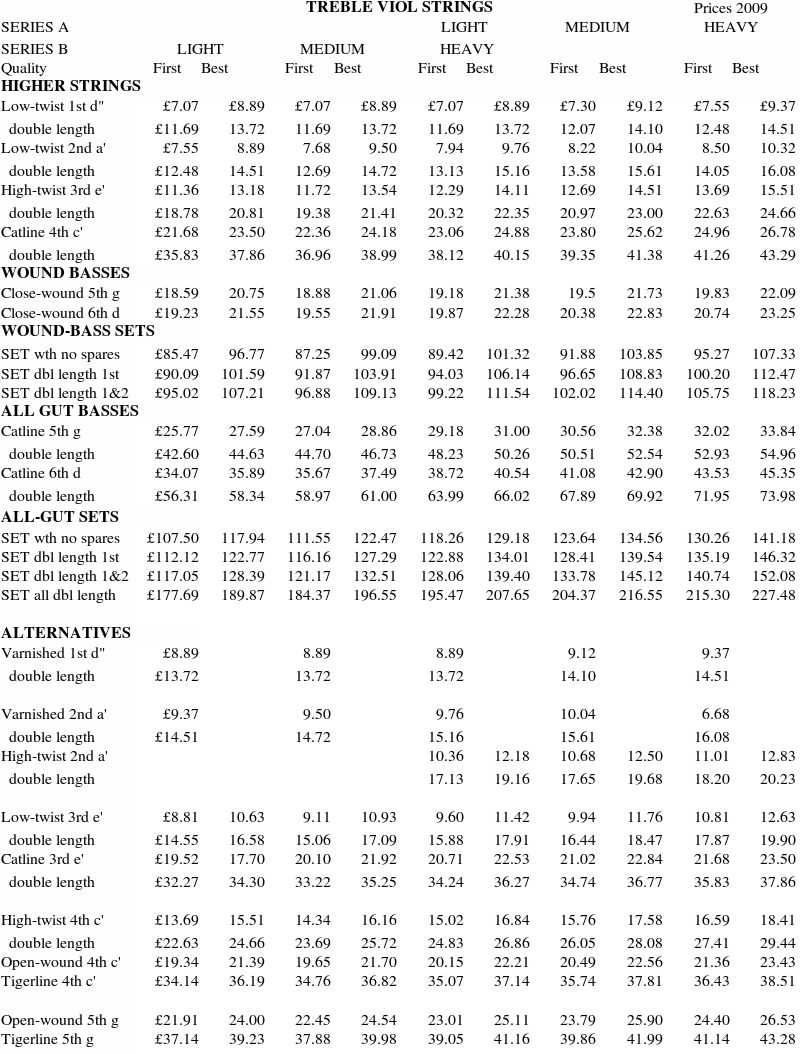
Northern Renaissance Instruments
6 Needham Avenue, Chorlton-cum-Hardy, Manchester M21 8AA, U.K.
Phone & Fax. +44 (0) 161 881 8134; proprietor: Dr. Ephraim Segerman [USA]
e-mail: post@nrinst.co.uk ; on internet: http://www.nrinst.co.uk
VIOL STRINGS
Types of Sets: The strings here offer a wide choice to suit the different requirements of most players. BEST covered strings are wound with Solid Silver, and BEST plain strings are treated with a modern material which enhances tuning stability and resists gut deterioration due to acid in finger perspiration. On request, an equivalent historical treatment by linseed oil can be substituted. FIRST Quality gut with Silver Plated Copper wound basses is our most popular stringing in the late baroque tradition, combining good resonant tone with ease of handling.
Diameters and Sets: When we started to make viol strings about 30 years ago, we measured the strings used by all of the experienced players we could find, and we called the most commonly used diameters (or equivalent diameters for wound strings) our 'Medium' sets. We designed Light and Heavy sets, and the range in-between covered the vast majority of what players used. A hand-full of players preferred lighter than our Light, so we offered X(extra)-Light, and heavier than our Heavy, so we offered X-Heavy. We now call these set specifications our 'Series A'.
Since then, there has been a minority of players preferring Light and X-Light sets for the treble viol and Heavy and X-Heavy sets for the bass viol for better balance in a consort. This is predicted by the Tension-Length Principle, which is that the string tension is proportional to the vibrating string length, for equivalent apparent sound output on instruments of different sizes of the same type. This Principle is followed nowadays by the violin family and lutes, and wherever we have historical information. There is but one piece of English historical information about viol string diameters, and that indicates that for a bass viol of modern size, the stringing would have corresponded with our Heavy set. We have consequently deduced our Series B sets, which include this information and conform to the Tension-Length Principle. Currently, the majority of players prefer Series A for their treble viol sets, and Series B for their bass viol sets. Alto viols (the original size for treble viols, tuned a tone lower) work well with Series A treble viol strings, but they may have to be longer.
The numbers in the following Table are the string diameters or equivalent diameters (ED's) of catline or wound strings, expressed in 'thou' (thousandths of an inch).

PRICES


The two columns above and on the left are a conversion table of string diameters or equivalent diameters (ED's) from thou to mm. Strings wound with silver-plated copper and just copper cost the same, and are in the 'First' columns. Solid silver windings are in the 'Best' columns. Surcharges for catline polishing are £5.95 for treble (£11.90 for a double length), £7.70 for tenor and £9.80 for bass viol.
